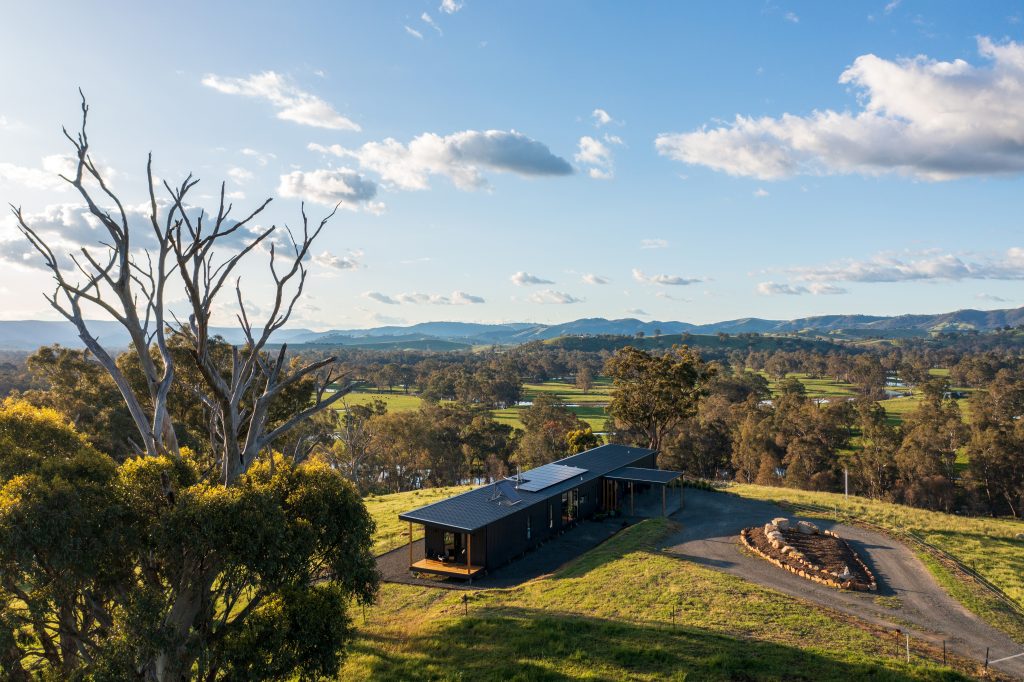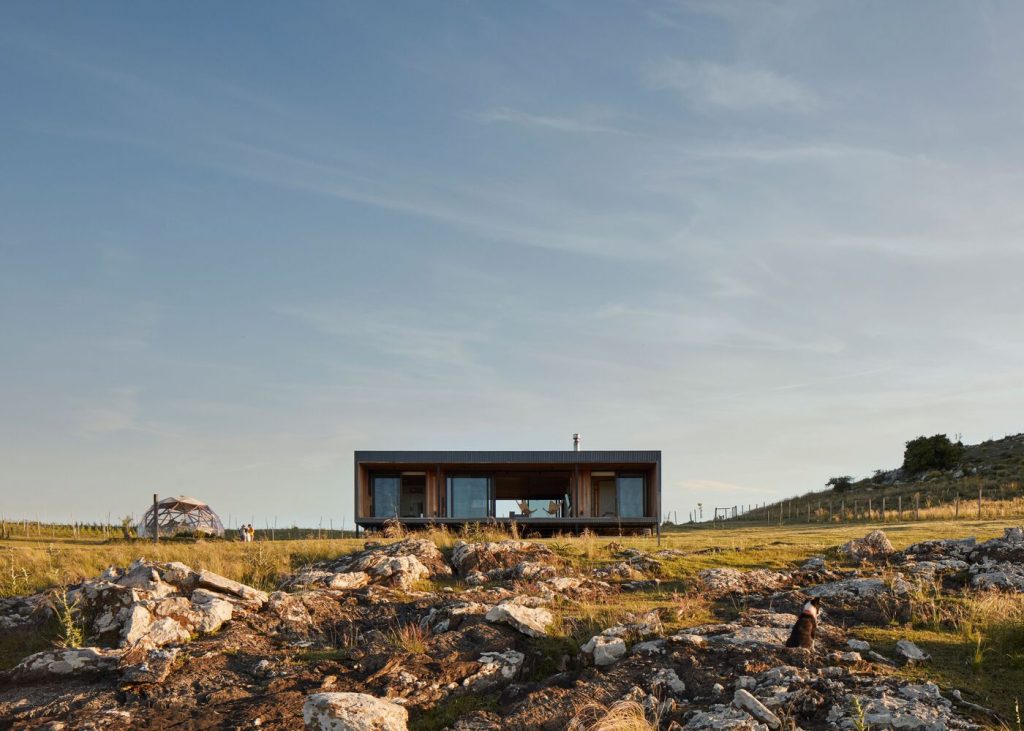Companies have sprung up around Australia to produce housing that offers a new option amid the property crisis, and now governments are taking notice.
They were the hallmark of postwar Britain, known for being quick to construct, built to last, clad with asbestos, dull and repetitious.

Almost 80 years later, “prefabs” have been renamed and are back in play, after the New South Wales government committed $10m in the state budget to a trial of whether modular housing could “deliver faster quality social housing”.
It will be spent on assessing planning pathways, identifying how to build to the highest standards, and scouting potential suppliers and locations.
Prefabricated construction represents about 3% of Australia’s building industry, but its reputation as a cheap and nasty housing option is beginning to be challenged by sustainable, design-led and compact, yet expansive models.
Modular housing has been promoted both as a short-term measure to deal with the aftermath of natural disasters and a quick way to provide permanent family homes to help address Australia’s housing crisis.
Modular construction comes in several forms. It can be delivered “as a box” in finished form, as a flat pack – separate parts such as wall frames and floor panels – or as a kit of smaller components.
Ashley Beaumont, the founder and director of the modular housing company EcoLiv, says the decision to fund modular housing is a promising step forward, although only one part of a much bigger picture.

“Its cost-efficiency and faster construction make it a viable option to rapidly increase housing supply,” Beaumont says.
“However, while it’s a step in the right direction, we should also consider other critical factors like land availability, infrastructure and urban planning to ensure a comprehensive solution.”
EcoLiv’s homes use sustainable materials, producing custom-built or pre-designed module homes with a minimum seven-star energy rating, which can be completed in about 20 weeks. Prices begin at about $500,000 for a two-bedroom, two-module home, rising to about $650,000 for a three-bedroom, three-module home. They are customisable and aim to reduce ongoing running costs by as much as 30% as a result of passive solar design.
With growing demand, Beaumont hopes that government involvement will create more opportunities for collaboration and growth, particularly in social housing, where he says regulation and a resistance to change in the construction industry can often stand in the way.
Modular housing has been used recently as a quick solution for flood relief in the Northern Rivers of NSW and in central west towns such as Eugowra, but in some cases disaster relief programs have been marred by a lack of community consultation, small funding pools for buyback initiatives and inefficient rollouts.
Peter Maddison, architect and director of Maddison Architects and former host of Grand Designs Australia, says modular housing may not be the silver bullet, but it has its place.
“If modular housing was the saviour for our current housing crisis, it’d be everywhere, wouldn’t it?”, Maddison says.
“People will go for the easiest way through the mire of owning a home.”
Its great benefit is the low cost and the speed at which a house can be built.
“Affordability is about size and the predictability of outcome,” Maddison says.
“Because you’re building remote from the site, you’re not affected by the vagaries of weather and you can work 12 hours a day on it.”
But building modular homes quickly does not always mean they can be installed immediately.
“In terms of allowing permanent places to be built when they appear overnight or in someone’s back yard … councils are not sure how to deal with these lightweight deliverable homes that are done quickly,” says Maddison.
“So there’s there’s certain hoops you got to jump through to build a home, and that time could be 12 months.”
‘Time and cost efficiencies – with design excellence’
It was almost 10 years ago when Grand Designs planted the speed and affordability of kit homes in the minds of architecture enthusiasts with the Huf Haus. It proved that while replication keeps costs down, design constraints don’t have to result in cookie cutter housing.

Numerous companies have now turned that idea into an adaptable range of modular housing options aimed at giving homeowners more choice and control, whether on a large rural property, or using stackable modules in the city.
In the Victorian coastal town of Barwon Heads, John O’Donnell says building his modular home was a precise and seamless experience.
“It was great, because it meant what they said it would cost was exactly what it cost, as opposed to building your own house, where there always seems to be vast numbers of things that go wrong,” he says.
Using a customisable design from Arkular, he created a five-bedroom house using two main modules and a joining module which acts as a corridor.
O’Donnell has added a garage and water tanks, and has plans to install solar panels on site. With these additions and other work, it cost about $700,000.
“I’ve been through house building before … and like most people found it not a very pleasant experience,” O’Donnell says.
“You get there in the end, but it takes a long time. And this did not. I could pop out there and just watch it being built in front of my eyes.”
Arkular offers customisable or pre-configured designs from one bedroom to four, which can be built in 12 to 20 weeks, and is only one of numerous companies now offering modular options.
Wild Modular, showcasing some innovative designs, was enlisted by the NSW government in 2022 to produce homes for flood-affected Lismore.
Prefabulous has a suite of multi or single module designs for “coastal”, “rural” or “hinterland” settings and has recently received government funding to produce a net zero modular housing model in collaboration with the University of Wollongong.
And FabPreFab champions timber-led modular design, two of which received commendations in the 2021 House Awards.
This year Blok Modular and the architects Vokes and Peters won the same award for the best new house under 200 sq m for their Stafford Heights project.
Delivered as separate prefabricated components and assembled on a site with a small footprint, the project combined a pavilion with landscaping such as block-work garden walls.
Alexa Kempton, the editor of Houses magazine, says the project showcased the potential of modular housing.
“What made it a winner was that it combined the benefits of prefab construction – the time and cost efficiencies that come with that methodology – with design excellence,” Kempton says.
She says Stafford Heights demonstrates that prefabrication does not mean compromising on any of the elements that previously gave it an image problem – “aesthetics, quality and durability”.

State governments around the country have begun to show serious interest. Queensland has committed to continuing its apprentice-led QBuild program, manufacturing prefabricated homes in a Brisbane factory. Correctional Services NSW has committed to increase the number of modular homes it will build by June 2025 to increase Indigenous housing supply. And in Victoria the state government has begun delivering modular housing designed by Arkit to those at risk of homelessness.
Maddison says changing attitudes is vital. Australia has the largest homes on average in the world and modular housing – like the tiny homes movement – encourages people to think about having a smaller footprint.
“If you can swing people’s aspirations around to being leaner, more stripped back, and not based on a French provincial or a Georgian home … people can digest the simplicity of modular building without all the paraphernalia, and it is just as affordable.”
O’Donnell says the simplicity of modular design meant he was not encouraged to “build the Taj Mahal” but had enough design choices to shape his project into much more than a box.
“I’ve had lots of comments, because there is a walking track not very far from there, so a lot of local people see it.
“The look of it is good, it’s got a character of its own and it’s really easy to look after and to live in.”
